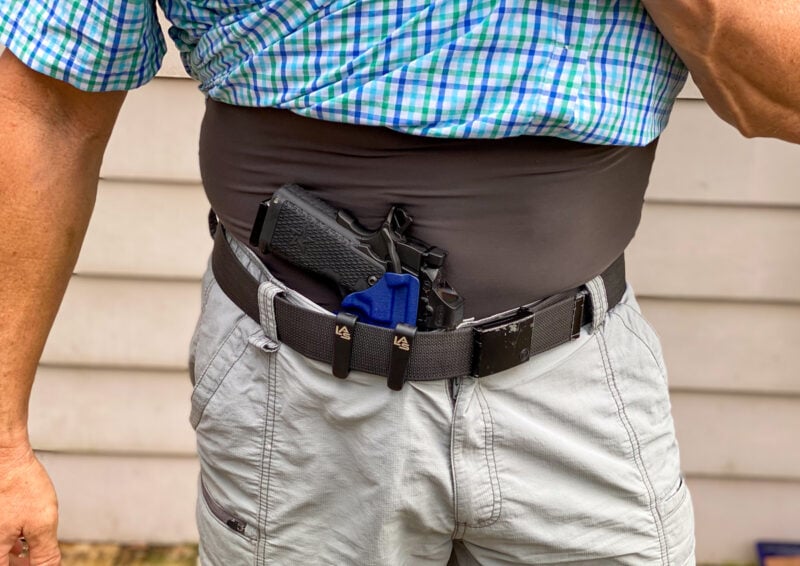6 Lessons Learned
About Appendix Carry
For some reason, we in the guns and shooting community seem to be equally plagued with the human tendency to hear stuff and gleefully forward it along as accepted gospel, rarely stopping to subject said information to rigorous critical thinking. Don’t get me wrong, I’m as guilty as the next guy, but every now and then, a burst of cosmic gamma rays or perhaps a bad frozen burrito wrench me from my lemming-like stupor and make me step back and re-examine some topic.
Such is the case with appendix carry. For years, I was clearly in the “you’ll shoot your ^&*%s off” crowd. At other times during this era, I was a card-carrying member of the “you’ll just perforate your femoral artery and bleed out all over the floor” society. When I wasn’t looking down my nose over one of those pithy observations, I joined the “it’s as uncomfortable as some of those individual immunity challenges they concoct for survivor contestants” club.
Then, one day, I woke up with a fleeting glimpse of common sense and decided to try appendix carry before continuing to pass judgment. What a novel concept! After some thought, I figured I ought to give it a long-term try. If it was going to be anything like the transition from not carrying a gun to carrying concealed daily, I figured I was in for plenty of trial and error — a short “try and judge” strategy wasn’t going to cut it.
So, off I went, trying a slew of guns, holsters and techniques. And I learned some things. And here we are, finally at the point of sharing some of the learnings I picked up from others and good old-fashioned trial and error. One more thing. I’m not an evangelist for appendix carry. We each must make our own decision on that. I’m just passing along what I’ve learned for the potential benefit of those who want to give it a fair try.
The Right Holster
There is no magic holster for appendix carry. There’s only the holster that works best for you and the specific gun you’re choosing. I carry a handful of different pistols in that up-front position and, with few exceptions, use different makes of appendix holsters for different guns and configurations.
For example, I’ve been using a LAS Concealment Shogun for the Staccato P model 2011. The aggressive concealment wing helps push the large grip toward my body. The clips are adjustable for cant, and for this large gun, I find a touch of angle rotating the gun a bit counterclockwise makes a big comfort difference. The holster has a closed mouth, which creates a rounded and, again, more comfortable body contact point when I sit.
As for a Springfield Armory XD-S Mod 2 I also frequently carry, I’ve been using a 1791 Gunleather Kydex IWB. Like the LAS Shogun, it’s optics-friendly, and I have optics on both guns. The wide single clip works fine for the shorter and lighter XD-S, and I don’t need the cant feature, although the holster has that adjustment. The molded-in concealment wing is still aggressive enough to help tuck the grip.
The Right Belt
Thickness matters. When carrying up front, I’ve found that every millimeter of overall thickness matters — a lot. Consider all the layers: foam backer (hold that thought, we’ll get to it), back of the holster shell, gun, front of the holster shell, back of the clip, belt and front of the clips. And don’t forget the belt buckle. All this adds to the occupied space between your body and your cover garment. While keeping things thin helps with concealment, it’s really about comfort. The more “working space” there is, the more the gun can shift around as I move and find a comfortable position.
Recently, I’ve been getting the best results with the sturdy Minimalist Nylon Belt from CrossBreed Holsters. It’s less than half the thickness of a leather belt but still rigid and ideal for carry.
Foam Rubber
This learning (from other more experienced appendix carriers) cannot be stated enough. If your midsection is anything “thicker” than a chiseled 6-pack, try sticking a large piece of foam on the inside of the holster, between the gun and your body. It made a 613% improvement in comfort, especially when sitting. It also resulted in a 389% improvement in concealment as it drives the grip towards the body, not letting it flop forward over the beltline.
One more benefit to the foam approach: it drives the muzzle forward, away from your body, adding a small extra layer of muzzle direction safety.
Loosey Goosey
While related to the “right belt” learning, this one is independently adjustable. If things are jabby and uncomfortable, try loosening your belt a notch, allowing the gun to shift around just a bit. As long as you’re using a rigid gun belt, carry security won’t be compromised.
A Few Degrees Matter
Try side-to-side repositioning if you’re struggling. I tend to carry ever so slightly off-center toward the strong side. Your mileage may vary. Some people have better success in the one to two o’clock position; others have the best success right in the middle. Some of this may depend on your holster. If you choose a “sidecar” model with an attached magazine carrier, you’ll need to position the gun just off-center so the magazine is off-center on the other side.
Safety First
Before making any go or no-go decisions, experiment with an unloaded or blue gun if you have it. Small changes matter.
Whatever carry method you choose, be safe about it. Always check any safeties or decocker status before re-holstering. Make sure your trigger finger is clear. When carrying appendix, shove your hips forward a bit when re-holstering; that will keep the muzzle pointed away from your body until the gun is secure. Above all, always holster reluctantly; there are no extra points or benefits to speed re-holstering.
Get more exclusive online content delivered straight to your inbox. Sign up for our free American Handgunner Insider newsletter.







